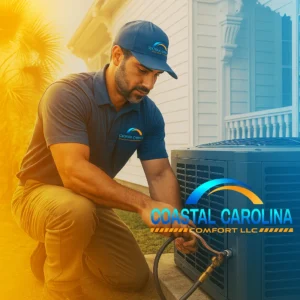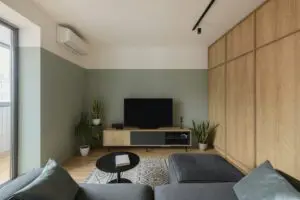When the AC fan stops working in the middle of a Charleston summer, it doesn’t take long to notice. The air inside your home gets warmer, the unit might start to hum without moving any air, and you’re left wondering what went wrong. These issues pop up more often than you’d think, especially during peak cooling season when your system is working the hardest.
Some problems with the AC fan are simple, while others are a bit more serious. Either way, when you know what signs to look for, you can catch the problem early and prevent bigger headaches. Understanding the reasons your AC fan might stop working helps you address the issue quickly and avoid sitting in a hot, uncomfortable house longer than necessary.
Common Reasons Your AC Fan Stops Working
There are a few key components that control your AC fan, and when just one of them fails, the whole system can start acting up. Most of the time, it comes down to a handful of parts that either wear out, short out, or lose connection. Here’s a breakdown of what could be behind the problem:
– Tripped breakers or blown fuses: If the fan isn’t turning on at all, it might not be getting any power. This could happen if a breaker flips or a fuse blows, usually from overheating or a short circuit.
– Thermostat errors: Sometimes, it’s not your AC that’s confused. It’s your thermostat sending mixed signals. If it misreads your home’s temperature or its batteries are dead, the AC fan might not get the message to turn on.
– Burned-out motor: Fan motors do a lot of work keeping air moving through your system. Over time, they can overheat or seize up entirely, especially if airflow has been blocked or the unit is dirty.
– Capacitor failure: The capacitor gives your fan motor the boost it needs to get spinning. If it fails, nothing happens when your air conditioner kicks on.
– Contactor problems: This is a small but important component. If the contactor gets stuck or goes bad, it can stop power from reaching the fan motor.
These parts don’t always fail without showing signs. You might hear buzzing or clicking when the unit tries to start, smell something burning near the outdoor unit, or notice the fan starts and stops at random. One Charleston homeowner recently thought their system was running fine since the outside unit was humming, but the fan blades weren’t spinning at all. The temperature inside kept rising, and no cool air came through the vents.
Spotting these symptoms early can help you catch an issue before it turns into a complete breakdown. That saves you both time and stress, especially during Charleston’s hottest weeks.
DIY Troubleshooting Steps
Before calling a professional, there are a few basic checks you can try. These don’t require special tools or technical experience, and they might help you figure out what’s going on.
1. Check the Circuit Breaker: A tripped breaker is one of the most common reasons your AC fan might stop working. Head to your breaker panel and see if the switch tied to your AC unit has flipped. If it has, try flipping it back. If it trips again after a short time, there could be a deeper issue that needs professional attention.
2. Thermostat Settings: Double-check that your thermostat is set to cool and that the temperature is set lower than the room temperature. Sometimes a simple mistake in settings is the whole problem. If the display looks faded or blank, try replacing the batteries or doing a reset.
3. Inspect for Obstructions: Step outside and take a look at your AC’s outdoor unit. Are there sticks, leaves, or other debris around or inside the unit? Any of these can block the fan blades and stop them from spinning. Make sure the power is fully off before you take a closer look, and gently clear away anything you find.
4. Listen and Look for Signs: Press your ear closer to the unit when it tries to turn on. Do you hear odd noises like buzzing or clicking? Do you smell anything burnt? These signals could point to a mechanical or electrical issue. If you notice anything unusual, it’s best to stop here and call a professional.
Your safety comes first. If anything seems off or feels too complicated, don’t push it. AC systems involve electric components that aren’t safe to handle without training. When in doubt, step back and contact someone who’s qualified.
Professional Solutions
If the fan still won’t work after some quick checks, bringing in a professional is the smartest move. Licensed HVAC technicians know how to quickly test and locate the source of the problem. Whether it’s a damaged motor, a faulty capacitor, or a bad wire connection, they’ll know what to look for and how to fix it properly.
Here’s what you get when you hire a pro:
– Expert Diagnosis: HVAC technicians have the training and experience to spot both obvious and hidden issues right away. They’ll check your entire system and figure out exactly what’s behind the malfunction.
– Preventative Repairs: Besides fixing the problem on hand, they can tell if something else is close to failing. That way, you won’t face another breakdown a few weeks down the road.
– Quality Parts and Installation: Some components need perfect placement and calibration, like capacitors or contactors. A professional will make sure everything is done correctly so the system runs smoothly again.
Trying to guess your way through a repair can be frustrating and risky. Trusting a certified technician protects your comfort and the equipment itself, especially during the hot Charleston summers when you can’t afford to be without reliable cooling.
Preventive Measures to Avoid AC Fan Issues
Once your AC fan is back up and running, keeping it in good shape should be part of your regular routine. Prevention goes a long way, especially in a place like Charleston where summer strains your system daily.
– Regular Filter Changes: Dirty air filters can slow airflow, forcing your fan motor to work harder. Over time, this strain can lead to overheating and failure. Get into the habit of changing your filter every couple of months or sooner if you notice it’s clogged.
– Professional Inspections: Set a schedule to have your system inspected by a pro at least once a year. During these visits, technicians check wire connections, clean internal components, and spot small issues before they become big ones.
– Keep the Outdoor Unit Clear: Leaves, mulch, grass clippings, and other yard debris can pile up around the outdoor unit. Clear a two-foot space around the whole unit and trim back bushes or plants. That gives the fan room to breathe and keeps it from getting jammed.
Taking care of your system a little bit at a time pays off when it counts. The fewer obstacles your AC fan faces each summer, the better it will perform—and the fewer surprise repairs you’ll have to deal with.
Stay Cool with Reliable AC Help in Charleston
Hot, humid days are when your AC matters most, so catching fan issues early is the key to staying comfortable. Whether you’re noticing odd noises, weak airflow, or total silence when your system kicks on, getting professional support quickly can make all the difference. Regular maintenance and timely service help prevent unexpected breakdowns and give you the peace of mind that your home will stay cool all summer.
When your AC fan stops working, don’t sweat it out. Turn to trusted help in Charleston and keep your system running strong.
Stay ahead of Charleston’s sweltering summers by keeping your cooling system in peak condition. If you’re dealing with AC issues and need dependable service, let us help. Learn how we can provide trusted AC help in Charleston to keep your home cool and comfortable all season long. Coastal Carolina Comfort is ready to handle all your cooling needs.


